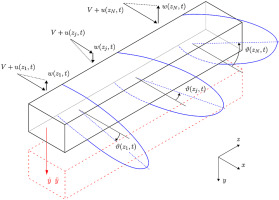当前位置:
X-MOL 学术
›
J. Wind Energy Ind. Aerod.
›
论文详情
Our official English website, www.x-mol.net, welcomes your
feedback! (Note: you will need to create a separate account there.)
Incorporation of turbulence in a nonlinear wake-oscillator model for the prediction of unsteady galloping response
Journal of Wind Engineering and Industrial Aerodynamics ( IF 4.2 ) Pub Date : 2020-05-01 , DOI: 10.1016/j.jweia.2020.104141 Claudio Mannini
Journal of Wind Engineering and Industrial Aerodynamics ( IF 4.2 ) Pub Date : 2020-05-01 , DOI: 10.1016/j.jweia.2020.104141 Claudio Mannini

|
Abstract The aeroelastic behavior of certain slender bluff bodies is known to be dominated in smooth flow by the interference of vortex-induced vibration and transverse galloping. In turbulent flow, wind tunnel experiments revealed a more complicated behavior, with some features that have not been fully understood yet. With the aim to explain the oscillation response observed for a sharp-edge rectangular cylinder with a side ratio of 1.5 and to make a step ahead in the simulation of the self-excited behavior of such bodies, a nonlinear wake-oscillator model that provided promising results in smooth flow is considered. The differential equations are randomized to account for the contribution of three-dimensional, partially-correlated, turbulent velocity fluctuations attacking the structure. Given the physical basis of the mathematical model, all the parameters but one are estimated based on wind tunnel tests on a stationary sectional model. In contrast, given the lack of wake measurements, one of the coupling coefficients in the equations is calibrated based on the cylinder response for a given value of the nondimensional mass-damping parameter (Scruton number). Then, the model is used to predict the vibrations recorded for very different values of the Scruton number, showing satisfactory accuracy. This fact highlights the key role played, even in turbulent flow, by vortex shedding and the importance of its nonlinear interaction with oncoming wind velocity fluctuations. The equations are also used to investigate the effect of turbulence intensity and integral length scale. In agreement with the experimental evidence, the response of the cylinder is found to be little sensitive to flow velocity fluctuations with small intensity (say, less than about 4%), but is remarkably affected by strong turbulence. The simulations also disclose a significant influence on the vibration amplitude of the integral length scale of turbulence. Finally, the proposed model might represent a useful engineering tool to estimate the unsteady galloping behavior of a slender structure immersed in a realistic large-scale turbulent flow, which seldom can be correctly reproduced in the wind tunnel.
中文翻译:

在非线性尾流振荡器模型中加入湍流以预测不稳定的飞驰响应
摘要 已知某些细长钝体的气动弹性行为在光滑流动中受涡激振动和横向飞驰的干扰。在湍流中,风洞实验揭示了更复杂的行为,其中一些特征尚未完全了解。为了解释边比为 1.5 的锐边矩形圆柱体观察到的振荡响应,并在模拟此类物体的自激行为方面领先一步,非线性尾流振荡器模型提供了有希望的考虑到平稳流动的结果。微分方程是随机的,以解释攻击结构的三维、部分相关、湍流速度波动的贡献。给定数学模型的物理基础,除了一个参数之外的所有参数都是基于固定截面模型的风洞试验估算的。相比之下,由于缺少尾流测量,方程中的耦合系数之一是根据给定的无量纲质量阻尼参数(Scruton 数)值的圆柱响应来校准的。然后,该模型用于预测针对非常不同的 Scruton 数值记录的振动,显示出令人满意的准确性。这一事实突显了涡旋脱落所起的关键作用,即使在湍流中,以及其与迎面而来的风速波动的非线性相互作用的重要性。这些方程还用于研究湍流强度和积分长度尺度的影响。与实验证据一致,发现圆柱体的响应对小强度的流速波动几乎不敏感(例如,小于约 4%),但受强湍流的影响显着。模拟还揭示了对湍流积分长度尺度的振动幅度的显着影响。最后,所提出的模型可能代表一种有用的工程工具,用于估计细长结构沉浸在真实的大规模湍流中的非定常飞驰行为,而这种湍流很少能在风洞中正确再现。
更新日期:2020-05-01
中文翻译:

在非线性尾流振荡器模型中加入湍流以预测不稳定的飞驰响应
摘要 已知某些细长钝体的气动弹性行为在光滑流动中受涡激振动和横向飞驰的干扰。在湍流中,风洞实验揭示了更复杂的行为,其中一些特征尚未完全了解。为了解释边比为 1.5 的锐边矩形圆柱体观察到的振荡响应,并在模拟此类物体的自激行为方面领先一步,非线性尾流振荡器模型提供了有希望的考虑到平稳流动的结果。微分方程是随机的,以解释攻击结构的三维、部分相关、湍流速度波动的贡献。给定数学模型的物理基础,除了一个参数之外的所有参数都是基于固定截面模型的风洞试验估算的。相比之下,由于缺少尾流测量,方程中的耦合系数之一是根据给定的无量纲质量阻尼参数(Scruton 数)值的圆柱响应来校准的。然后,该模型用于预测针对非常不同的 Scruton 数值记录的振动,显示出令人满意的准确性。这一事实突显了涡旋脱落所起的关键作用,即使在湍流中,以及其与迎面而来的风速波动的非线性相互作用的重要性。这些方程还用于研究湍流强度和积分长度尺度的影响。与实验证据一致,发现圆柱体的响应对小强度的流速波动几乎不敏感(例如,小于约 4%),但受强湍流的影响显着。模拟还揭示了对湍流积分长度尺度的振动幅度的显着影响。最后,所提出的模型可能代表一种有用的工程工具,用于估计细长结构沉浸在真实的大规模湍流中的非定常飞驰行为,而这种湍流很少能在风洞中正确再现。











































 京公网安备 11010802027423号
京公网安备 11010802027423号